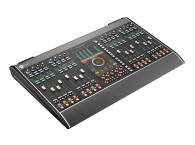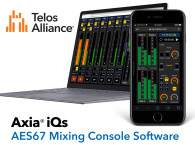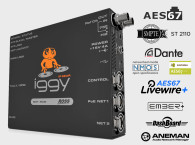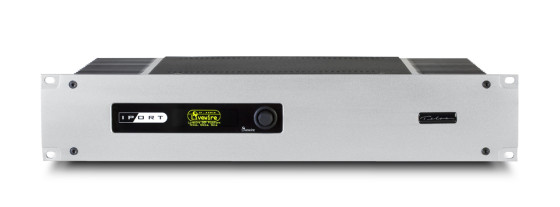
Radio network operators and broadcast professionals in search of a way to distribute multiple high quality channels of audio via IP are embracing the Telos Zephyr iPort PLUS, an astonishingly flexible networked 2RU codec tailored to the needs of program distribution and long-distance audio sharing between separate studio facilities.
iPort PLUS’ efficient use of high-density Livewire I/O audio-over-IP technology, combined with multiple codecs in a single 2RU device results in a low cost per channel, especially when compared to the cost of multiple single-channel codecs. Using Zephyr iPort PLUS, broadcasters can transport multiple channels of stereo audio across IP networks with guaranteed QoS, such as VPNs, satellite links, Ethernet radio systems, and Telco or ISP-provided QoS-controlled IP services.
“The introduction of Zephyr iPort PLUS with Content Delay marks the third iteration of this product,” notes Marketing Manager Clark Novak. “Broadcasters have found Zephyr iPort to be so amazingly useful that we’ve been driven to keep improving and adding features. In fact, Zephyr iPort PLUS is so full of capabilities that some clients are calling it the most flexible multi-channel IP codec on the planet!”
The debut of Zephyr iPort PLUS marks the addition of Content Delay to a device that already contains 16 stereo codecs in a bulletproof, fanless 2RU rack device. These 16 codecs may be configured either as 8 bi-directional codecs, 16 “encode” codecs, or 16 “decode” codecs. Content Delay is perfect for program distribution to large networks that span several time zones, allowing daypart-sensitive programming to be received and stored locally, ready to air automatically at the proper time in each location.
Zephyr iPort PLUS also adds a new codec choice, in addition to its already impressive selection of MPEG AAC algorithms: Telos has partnered with the UK’s CSR to offer aptX Enhanced coding as an option for broadcasters whose applications require it.

Standard iPort coding includes genuine Fraunhofer MPEG Layer 2, Layer 3, AAC and AAC-HE choices, plus low-delay AAC-LD, with special error resilience protection that conceals low levels of random packet loss. Zephyr iPort also includes AAC-HE v2 (High Efficiency + Parametric Stereo), the most bit-efficient codec available today. Uncompressed transmission is also supported using a linear coding mode that’s ideal for bit-perfect audio where higher bandwidth is available.
Zephyr iPort PLUS connects via standard IP networks, including private T1 or T3 lines, private WANs with MPLS, or even IP-radio links. Broadcasters with existing Axia IP-Audio networks will benefit from single-cable connection for all I/O and GPIO logic; stations without Axia can simply pair Zephyr iPort PLUS with Axia xNode audio interfaces for use as a standalone multi-stream codec.
The unit features multiple-protocol redundant stream send, and buffer-aligned receive paths with individual per-path VLAN tagging, plus UDP, TCP, and Multicast stream types, independently configurable per WAN stream. It also includes three bi-directional user data channels per codec, SNMP monitoring and 20 bi-directional GPIO closures per codec channel, with remote status signaling and control using virtual GPIO pins.
The optional Content Delay uses SSD-based dynamic storage space allocation, configurable per codec, with synchronized delay of GPIO and user data channels. NTP synchronization allows for absolute-time Content Delay playback.
Additionally, Zephyr iPort PLUS is convection-cooled for quiet, fanless operation and features Telecom-grade dual-redundant, field-replaceable power supply modules, designed for ultimate uptime under demanding service conditions.
The new Zephyr iPort PLUS will be displayed at the Telos Alliance display during NAB 2015 in Las Vegas.
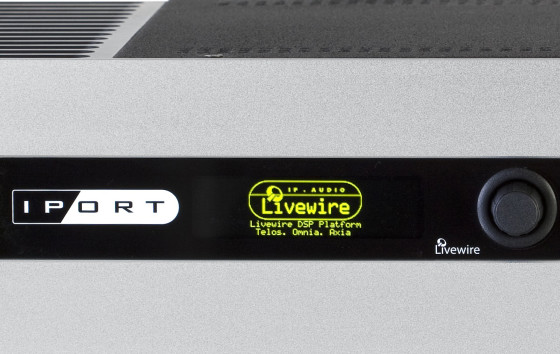
New Axia Livewire Partners
Over 80 broadcast hardware and software makers now provide broadcast products and services that work with Axia Audio Livewire AoIP networks, thanks to the addition of five new Axia Partners.
Florida-based AVRA (www.avra.tv) authors radio streaming software with video servAVRAer capabilities, allowing audiences to view broadcaster-provided visual content while listening to a radio station’s streaming channel on smartphones, tablets and other IP-connected devices.
Sonifex (www.sonifex.co.uk), U.K. manufacturers of radio & TV broadcast hardware and software, bought the Australian company Innes Corp in 2014 and are now distributing their Flashlog logging software bundled with the Axia IP-AuTriple Audiodio Driver for Windows.
Triple Audio (www.tripleaudio.com), of Bilthoven, Nederland, offers a variety of system integration and other services to broadcasters. Their automation software integrates smoothly with Axia IP-Audio Networks.
StreamS HiFi Audio (www.indexcom.com) from Modulation Index provides broadcasters with software tools that work with the Livewire IP-Audio Driver for Windows, originating high-quality AAC-LC/HE Audio streams for the Internet, as well as managing and synchronizing Program Associated Data.
Wegener (www.wegener.com), international maker of products and systems for complex video and audio networks, has become an Axia Hardware Partner under the Livewire Limitless License (L3) Program. This unique initiative allows manufacturers to build Livewire interfaces into as many hardware products as they like, with no per-unit license fee.
More than 5,500 radio studios are equipped with Axia AoIP networks, and over 60,000 devices now in the field connect via Livewire networking technology, developed by Axia parent Telos Systems. Livewire utilizes standard Ethernet to easily route and share audio and logic throughout broadcast plants. Livewire is also AES67-compliant. Broadcasters with Axia networks can easily exchange audio with any devices that adhere to the AES67 standard — ensuring future-proof operation.
TelosAlliance.com



